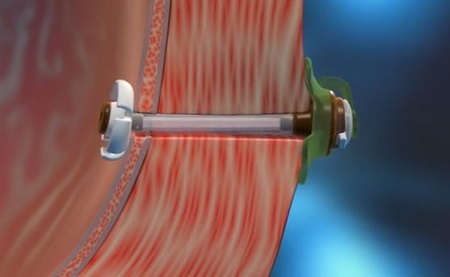
Whereas traditional feeding tubes often clog, dislodge, or degrade, a feeding tube invented by Hadassah Medical Organization Pediatric Gastroenterologist Dr. Ishay Benuri is designed to reduce all of these problems and improve the quality of life for patients and caregivers alike.
Globally, 1.3 million people are dependent on feeding tubes for nourishment because they are unable to absorb food orally, whether because of a stroke, Parkinson’s disease, dementia or other neurological impairment. This translates into four million tubes being inserted each year, as they need to be replaced when they get clogged, dislodged or degrade.
The new tube was developed by the Israeli start-up, Fidmi Medical, founded by Dr. Benuri. As with a traditional feeding tube, in order to implant the device, the surgeon inserts an endoscope through the patient’s mouth and guides it into the stomach. Through a camera on the endoscope, the doctor determines exactly where to insert the tube by making a small incision in the abdominal wall. With the tube in place, there is now a path to deliver nutrition directly into the gastrointestinal tract, bypassing the mouth and esophagus, the normal pathway leading to the stomach. How the uniquely designed tube works following insertion, however, is the important difference.
Many physicians, Fidmi Medical reports, recommend replacing a feeding tube every six to eight months. The structure of this tube, however, eliminates the need for repeated replacement because its flexible, yet rigid-core, silicone internal “bumper” keeps the tube in place better than the current soft bumpers. It reduces clogs, so that medicine and food flow freely.

With traditional feeding tubes, when replacement is required, the soft bumpers are meant to be removed along with the feeding tube. With this Fidmi new design, the entire device rarely needs to be removed because it features a disposable inner feeding tube, which is easily taken out and replaced by either the patient or caregiver. When the tube does need replacing, a special tool detaches it from the bumper, which, in turn, then breaks up and is expelled naturally from the body. In this way, only the tube has to be removed. As a result, this new Fidmi tube makes the procedure trauma-free, whereas traditionally, removing and replacing feeding tubes is an unpleasant, time-consuming procedure.
The Fidmi device was introduced at the Innovations in Gastroenterology International Conference in Tel Aviv this past January and is now undergoing its first clinical trial at Hadassah.
Read more about the Fidmi device and watch a video to see how it works at https://www.israel21c.org/easing-the-discomfort-and-complications-of-feeding-tubes/
